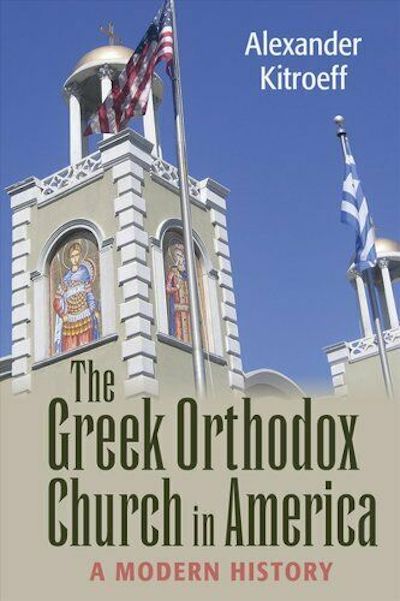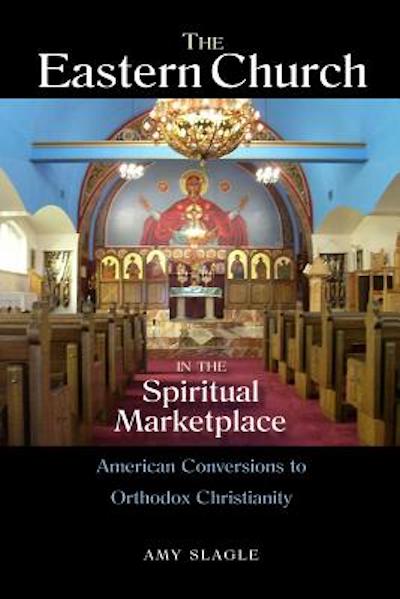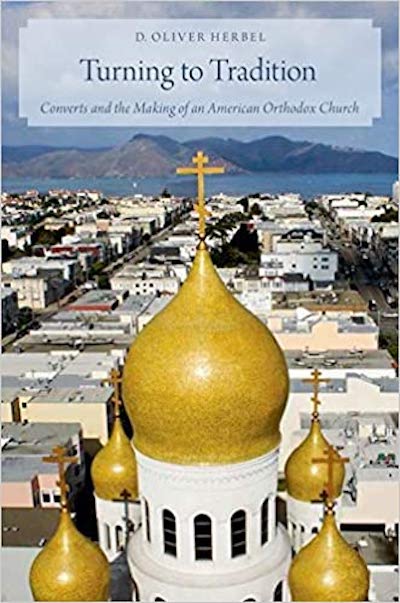D. Oliver Herbel, Turning to Tradition: Converts and the Making of an American Orthodox Church. New York: Oxford University Press. 2013. Pp. ix + 243. Paperback. $36.95.
Alexander Kitroeff, The Greek Orthodox Church in America: A Modern History. Dekalb: Northern Illinois University Press. 2020. Pp. xv + 312. Paperback. $29.95.
Amy Slagle, The Eastern Church in the Spiritual Marketplace: American Conversions to Orthodox Christianity. Dekalb: Northern Illinois University Press. 2011. Pp. 207. Paperback. $25.00.
In the past, studies of Orthodox Christianity have usually attended to geographical regions of the world that are typically associated with historic, often state-affiliated, branches of the faith. Orthodoxy in Greece, Eastern Europe, the Middle East, and Russia has long been the focus of investigation for researchers in a variety of disciplines. In contrast, global flows of Orthodoxy, particularly to North America, have received substantially less research, with scholars, such as Sergei Kan, mostly intrigued by historical transformative encounters between indigenous and native communities and Russian entrepreneurs and clerics in Alaska and the Pacific Northwest, or the religious syncretism that emerged in their wake. In recent years, however, particularly since the 2010s, Orthodox Christian studies has turned its attention more pointedly toward the United States, where the faith is expressed in overlapping jurisdictions, composed of both immigrant communities and American converts. This area has seemingly boundless potential for intersectional, interdisciplinary research, historical and contemporary, especially in light of the global conversations Orthodox Christianity takes part in, both socially and theologically.
The three monographs assessed in this review are indicative, in many ways, of the recent turn to the U.S. context in Orthodox Christian studies, providing substantive examples, in theory and methodology, of why and how this area of research is vital for the interdisciplinary development of the field. Alexander Kitroeff offers a sweeping social history of twentieth-century Greek Orthodoxy in the United States, while Amy Slagle and D. Oliver Herbel both provide narratives of conversion experiences, albeit with different methodological frameworks that assess multiple time periods. Herbel’s work looks at historical accounts of individual conversion, while Slagle, in the vein of qualitative sociology, gives her readers an ethnography of two contemporary communities with ample convert populations. Each of these three books generates compelling new framings of Orthodox Christianity in the United States, while also highlighting the need for more published research on a form of Christianity that has deeply shaped American religion(s) in both the local context and globally through its sociopolitical presence throughout the world.
The place of Orthodox Christianity in the public sphere of American religion(s) is seen and felt quite prominently in Kitroeff’s modern history. His book does an immense service; it provides a historical account of Greek Orthodoxy in the United States that not only addresses the structural development of the jurisdiction, but also explores the integral roles the Greek Orthodox Archdiocese (GOA), and its major ecclesiastical figures, played in American social politics during the twentieth century. Wrestling with looming social issues of migration, diaspora, and enculturation, Kitroeff’s work brings readers into the history of Greek Orthodoxy in the United States, drawing attention to the ways in which language, ethnicity, and identity were, and continue to be, worked out in public, transnational contexts. Kitroeff elucidates how the Greek Orthodox Church in the United States transformed during the twentieth century, moving from a church “overshadowed by tradition” to one that began to grapple with socially engaged means of meeting the needs of a rapidly modernizing society and an evolving ecclesiastical polity, despite social and political challenges (209).

Intraorganizational conflicts, often stemming from the desire to culturally and, to some extent, religiously become more embedded in American culture, plagued the GOA during the twentieth century. At the same time, however, the GOA also pushed forward with social outreach programs, including the creation of nursing homes, youth programs, and the formation of Philoptochos, the prominent and long-standing GOA women’s philanthropic organization. Exploring the influential relationships Patriarch Bartholomew and Archbishop Iakovos had with political leaders, Kitroeff provides insight into the GOA’s drive for social respectability, the challenges of enculturation, and the seemingly cultivated hybridity of Greek American Orthodoxy that emerged as a result of the emphasis on immigrant Americanization. Kitroeff’s history of the GOA reads as a useful primer for those of us studying Orthodox Christianity in the twenty-first century, where the challenges of the culture wars and geopolitics weigh heavy in our assessments of Orthodoxy in the United States, given the shifting political dynamics, particularly the move to the far right, that we find in many American Orthodox communities. A case in point are the communities with whom I work and for whom the global culture wars and Orthodox geopolitics are fundamental to understanding their social life worlds. By returning to the social histories of Orthodoxy in the United States, especially during the Civil Rights movement, scholars of contemporary Orthodoxy can better understand how the GOA and its leaders respond to current sociopolitical events, such as His Eminence Archbishop Elpidophoros’s (Lambriniadis) decision to march in a Black Lives Matter rally during the summer of 2020, an action that was met with both joy and contempt by different jurisdictional and individual factions within Orthodox Christianity.
Paradoxically, the Americanization process in the GOA often did not include openness toward conversion. Archbishop Iakovos was reticent up until the 1980s to embrace the idea of converts, while his contemporary, Metropolitan Phillip Saliba, paved the way for a large and steady influx of conversions in the Antiochian Archdiocese. The GOA’s early hesitation toward converts is one area of Kitroeff’s book that might benefit from a deeper dive into the intraorganizational politics of the GOA polity, especially given the fact that converts are now an integral part of Greek Orthodoxy and represent a growing segment of the clerical population. While Kitroeff’s book provides a broad historical overview that is focused on the GOA institutional engagement with American public life and politics, with only limited attention devoted to American conversions, Slagle’s sociological ethnography offers a small-scale assessment of conversion, looking particularly at its personal, emotive properties. Slagle’s multisited ethnographic study of contemporary American Orthodox Christians explores the individual reasons and rationale behind conversions to Orthodoxy. Using sociological theories steeped in the language of marketplace economics and choice, Slagle unpacks the religious experiences of Orthodox parishioners in Pittsburgh, Pennsylvania, and Jackson, Mississippi, to investigate what drew them toward and into the Orthodox Church. However, her theoretical analysis never fully answers the question of why Orthodoxy might be attractive to Americans. Still, Slagle’s two-pronged approach—that of ethnography and theoretical analysis—was (and is) a substantial step in Orthodox Christian studies as it seems to be one of the first of its kind to shift away from the theological, historical, and confessional literature that has been prevalent in scholarship on Orthodoxy in the United States.

Slagle’s ethnography of two American Orthodox communities explores convert beliefs and practices, gesturing to yet never fulling acknowledging the complicated, often neocolonialist relationship conversion has with the global, diasporic, and ethnic nature of Orthodoxy in the United States. Yet, while Slagle’s analysis is crucial in helping her readers understand many of the emotive and affective components of conversion, she often fails to fully utilize the rich qualitative data her fieldwork has yielded, with little-to-no analysis of the larger issues outside of the personal dynamics of conversion. Major intersectional issues, such as race, gender, and sexuality, are only superficially analyzed for their sociocultural significance among converts, not to mention their larger connections to themes of imperialism, neocolonialism, and appropriation. This is particularly evident in the chapter on ethnicity, in which issues of heritage, whiteness, and masculinity are visible and ripe for substantive engagement but are seemingly confined to Slagle’s theoretical paradigm of identity and conversion, which does not question how race, gender identity, and class might affect the conversion process. What does it mean to adopt a religious identification that has its roots among marginalized ethnic communities? What roles do neocolonialism and white privilege play in the process of conversion? How might one’s social, economic, and educational background influence their decision to become Orthodox? There are a wide variety of sociocultural questions of being that Slagle does not attend to fully. Methodologically, Slagle’s selection of two field sites with wide socioeconomic and class differences is important to note. While Slagle does mention this in passing, it would have been beneficial to have a more contextualized account of the regional, geographical, and economic differences between her field sites, for these larger, embedded factors are part of the cultural and social act of conversion whether or not her interlocutors mention them. Slagle does offer a bit more demographic insight into both Orthodox communities in her first appendix, but this information is limited to data about her interlocutors and does not include information regarding the larger, non-Orthodox communities in which these conversions took place.
The lack of both ethnographic data from non-Orthodox locals and social information outside of the parish settings means that this ethnography is limited in its ability to provide readers with a full picture of the conversion process. Conversion is a socially constructed act that involves more than the religious beliefs or desires of those who pursue it; it is contoured not only by religious and familial histories, but by the social, cultural, and political context in which converts grow up, work, and live. To look predominately at the language of conversion and its spiritual properties negates the anthropological gravity of the situation, for conversion is a social, cultural, and political act. Slagle also acknowledges that her research with the Mississippi community is not as expansive as her research with Orthodox Christians in Pittsburgh. Indeed, the final section of the monograph, which focuses on the Delta community, feels like an addendum to the original research program. Perhaps the inclusion of this smaller data set denied Slagle the spatial possibility within her monograph of a more developed assessment of conversion expressed in the Pittsburgh community. Despite the methodological concerns, Slagle’s work is to be praised, for her ethnography has paved the way for the development of the anthropology of Orthodox Christianity in the United States, something that might not have been possible without her important intervention.
In a similar fashion to Kitroeff, Herbel also draws on Slagle’s work as he explores the individual reasons for conversion. Focusing on both historical and contemporary case studies of converted Orthodox leaders, Herbel argues that these conversions can be seen through the lens of restorationism, a movement that attempts to transform contemporary church practices into those popular during the early, developmental period of Christianity (3-4). Herbel suggests that converts use a “very American way,” namely that of personal choice and restorationism, to take part in Orthodoxy, “an un-American choice” (3-4). Herbel sees this as un-American because Orthodoxy, from his vantage point, is a religion not tied to the West or America. However, to label Orthodoxy as un-American is to view it through the lens of orientalism, reinforcing the East–West dichotomy that has plagued Orthodox studies for far too long. In order to explain his theories, Herbel inserts the conversion narratives of Fr. Alexis Toth, a canonized saint who converted Uniates to Orthodox Christianity, and Fr. Moses Berry, a contemporary African American convert, into his paradigm of ecclesiastical restorationism. In doing so, Herbel falls into the same methodological quandary as Slagle; he neglects the larger sociocultural, geographical, and temporal dimensions of conversion. The focus on restorationism creates a narrowly defined framework for conversion that removes it from the larger context of social transformation, thereby rendering it wholly other.

Crucial to Herbel’s restorationism paradigm is the draw of Orthodoxy as eastern or an eastern form of Christian spirituality, and yet he does not investigate the broader issues of orientalism and neocolonialism that are embedded in the dichotomous language of East and West. The history of American religions is rife with similar examples of ontological and spiritual turns to the so-called Eastern world. Transcendentalism, yoga, and Vedic practices are just some of the concepts Americans have embraced throughout the twentieth century because they read them as ontologically and geographically eastern. I agree with Herbel that Orthodox Christian converts in the United States often imaginatively construct the East as an image, a place, and a concept that is holy, sacred, and otherworldly in its alterity. However, I fail to see this as part of a restorationism paradigm; rather, the categorization of the East as wholly other is an expression of the historically embedded western notions of the east as a mystical portal to another reality. Had these conversions been placed in conversation with the larger discussions of orientalism and exoticism that we have seen within the history of American religion, these issues of geographical dualism might have surfaced more readily in Herbel’s work. Yet, in spite of these theoretical omissions, Herbel’s book provides us with crucial research on Orthodox Christian convert leaders that otherwise might have been neglected by scholars. Herbel’s monograph might have been the beginning of a movement that Slagle hoped for in the final section of her book. Toward the end, Slagle expressed her desire for the advancement of research on Orthodox conversion, particularly in the American south, alluding to the possibilities this type of research might have in the future transformation of Orthodox studies.
These three texts are not above critique. While Herbel and Slagle’s books, with their fine-grain assessment of conversions, lack thorough sociocultural analysis, Kitroeff’s monograph, which offers a sweeping look at the history of the GOA using archival documents and secondary sources, does not allow for substantive reflection on the lived experiences of Greek Orthodox Christians during the twentieth century. In all, each book offers an immense wealth of historical and contemporary data on Orthodox Christianity in the United States; without the assessments of Kitroeff, Herbel, and Slagle, our theoretical toolkits for the study of Orthodox Christianity would be incomplete. All three of these texts are foundational reading for those of us working on Orthodoxy in the United States. Highly readable, useful for teaching, and formative for future research, each book demands our attention and brings us into a deeper knowledge of how Orthodox Christianity has been lived, practiced, fought over, and transformed on American soil.
Sarah Riccardi-Swartz
is a postdoctoral fellow in the Luce-Funded Recovering Truth: Religion,
Journalism, and Democracy in a Post-Truth Era project in the Center for the
Study of Religion and Conflict at Arizona State University. An
anthropologist, scholar of American religion, and trained documentary
filmmaker, she specializes in social politics, media, and Orthodox
Christianity in the United States. Her research has been funded by New York
University, the Jordan Center for the Advanced Study of Russia, the
Louisville Institute, the Institute for Citizens and Scholars (formerly the
Woodrow Wilson National Fellowship Foundation), the National Endowment for
the Humanities, the Henry Luce Foundation, Leadership 100, the Orthodox
Christian Studies Center at Fordham University, Arizona State University,
and the Social Science Research Council in partnership with the Fetzer
Institute.
Cover Image
: “Cross in the Holler.” Sarah Riccardi-Swartz. 2017.
